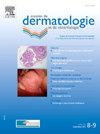Clinical course and prognostic disparities of pyoderma gangrenosum based on underlying disease: A long-term comparative study in 124 patients
IF 3.1
4区 医学
Q2 DERMATOLOGY
引用次数: 0
Abstract
Background and objectives
Pyoderma gangrenosum (PG) is associated with inflammatory bowel disease (IBD), autoimmune and connective tissue diseases, and hematologic malignancies. The impact of these underlying diseases on the clinical course and outcomes of PG remains poorly understood. This study investigates the influence of systemic disease associations on the progression, treatment response, and prognosis of PG.
Patients and methods
This study followed a cohort of 124 patients diagnosed with PG at a multidisciplinary referral institution between 2007 and 2024. Patients were stratified into four groups: IBD-associated PG (n = 52), autoimmune and connective tissue disease-associated PG (n = 24), hematologic malignancy-associated PG (n = 15), and idiopathic PG (n = 33). Outcomes, including remission and relapse rates, were analyzed using Kaplan-Meier survival curves and Cox proportional hazards models.
Results
IBD-associated PG had the most favorable outcomes, with 75% of patients achieving remission at 12 months (M12) (Hazard Ratio [HR]: 2.56; 95% Confidence Interval [95%CI]: 1.49–4.35). Autoimmune and connective tissue disease-associated PG was the most treatment-refractory, with only 8.3% achieving remission at M12 (HR: 0.21; 95% CI: 0.10–0.50). Relapse occurred in 26.1% of patients, with no significant difference across the groups (p = 0.8). Bullous PG, predominantly linked to hematologic malignancies, exhibited accelerated healing but also a high rate of malignant transformations near PG onset.
Conclusions
IBD-associated PG followed a more favorable clinical course compared to autoimmune and connective tissue diseases or hematologic conditions, highlighting the importance of tailored treatment approaches based on underlying disease associations.
基于基础疾病的坏疽性脓皮病的临床病程和预后差异:124例患者的长期比较研究
背景与目的坏疽性皮肤病(PG)与炎症性肠病(IBD)、自身免疫性和结缔组织疾病以及血液系统恶性肿瘤相关。这些潜在疾病对PG的临床过程和结局的影响仍然知之甚少。本研究探讨了全身性疾病关联对PG进展、治疗反应和预后的影响。患者和方法本研究随访了2007年至2024年间在多学科转诊机构诊断为PG的124例患者。患者被分为四组:ibd相关PG (n = 52),自身免疫和结缔组织疾病相关PG (n = 24),血液恶性肿瘤相关PG (n = 15),特发性PG (n = 33)。结果,包括缓解率和复发率,使用Kaplan-Meier生存曲线和Cox比例风险模型进行分析。结果sibd相关PG的预后最有利,75%的患者在12 个月(M12)时获得缓解(风险比[HR]: 2.56;95%置信区间[95% ci]: 1.49-4.35)。自身免疫性和结缔组织疾病相关的PG是最难治疗的,只有8.3%的患者在M12时获得缓解(HR: 0.21;95% ci: 0.10-0.50)。复发发生率为26.1%,两组间无显著差异(p = 0.8)。大疱性PG,主要与血液系统恶性肿瘤有关,表现出加速愈合,但在PG发病附近也有很高的恶性转化率。结论与自身免疫性和结缔组织疾病或血液学疾病相比,sibd相关的PG具有更有利的临床病程,突出了基于潜在疾病关联的量身定制治疗方法的重要性。
本文章由计算机程序翻译,如有差异,请以英文原文为准。
求助全文
约1分钟内获得全文
求助全文
来源期刊
CiteScore
1.40
自引率
0.00%
发文量
70
审稿时长
81 days
期刊介绍:
Les Annales de dermatologie sont le rendez-vous mensuel incontournable de toute la dermatologie francophone, grâce à leur comité de rédaction qui assure une sélection rigoureuse des articles selon les normes de l''édition scientifique internationale.
Une revue didactique, véritable aide à la pratique médicale quotidienne
Pour compléter et enrichir la partie scientifique, la rubrique Formation médicale continue propose aux lecteurs des textes didactiques et interactifs (Cas pour diagnostic, Notes de pharmacovigilance, la Question du praticien, Dermatologie chirurgicale, la Sélection bibliographique du mois...) qui les font bénéficier d''une formation post-universitaire diversifiée et de qualité. La revue consacre également un espace pour la publication de questions des lecteurs auxquelles des experts apportent une réponse.

 求助内容:
求助内容: 应助结果提醒方式:
应助结果提醒方式:


